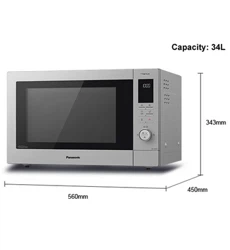Loading ...
Loading ...
Loading ...

– 11 –
Installation and General Instructions
(continued)
4. Potatoes, apples, egg yolks, chicken wings, whole
squash and sausages are examples of foods with
nonporous skins. This type of food must be pierced
before cooking, to prevent bursting.
5. When heating liquids, e.g. soup. sauces and
beverages in your microwave oven, overheating
the liquid beyond boiling point can occur without
evidence of bubbling. This could result in a
sudden boil over of the hot liquid. To prevent this
possibility the following steps should be taken:
(a) Avoid using straight-sided containers with
narrow necks.
(b) Do not overheat.
(c) Stir the liquid before placing the container in the
oven and again halfway through cooking time.
(d) After heating, allow to stand in the oven for
a short time, stirring again before carefully
removing the container.
(e) Microwave heating of beverages can result in
delayed eruptive boiling, therefore care must
be taken when handling the container.
6. DO NOT USE A CONVENTIONAL MEAT
THERMOMETER IN THE MICROWAVE
OVEN. To check the degree of cooking
of roasts and poultry use a MICROWAVE
THERMOMETER. Alternatively, a conventional
meat thermometer may be used after the food
is removed from the oven. If undercooked,
return meat or poultry to the oven and cook
for a few more minutes at the recommended
power level. It is important to ensure that meat
and poultry are thoroughly cooked.
7. COOKING TIMES given in the Cooking Guide
section are APPROXIMATE. Factors that may
affect cooking time are preferred degree of
moisture content, starting temperature, altitude,
volume, size, shape of food and utensils used.
As you become familiar with the oven, you will be
able to adjust for these factors.
8. It is better to UNDERCOOK RATHER THAN
OVERCOOK foods. If food is undercooked, it
can always be returned to the oven for further
cooking. If food is overcooked, nothing can be
done. Always start with minimum cooking times
recommended.
9. Extreme care should be taken when cooking
popcorn in a microwave oven. Cook for minimum
time as recommended by manufacturer. Use
the directions suitable for the wattage of your
microwave oven. NEVER leave oven unattended
when popping popcorn.
10. When heating food in plastic or paper containers,
keep an eye on the oven due to the possibility of
ignition.
11. The contents of feeding bottles and baby food jars
are to be stirred or shaken and the temperature
is to be checked before consumption, in order to
avoid burns.
Microwaves and How They Work
Microwaves are a form of high frequency radio waves
similar to those used by a radio, including AM, FM
and CB. They are similar to a television where the
radio waves are converted to a picture on the screen.
However, microwaves are much shorter than radio
waves; approximately twelve centimetres wave length.
Electricity is converted into microwave energy by the
magnetron tube (which is the heart of the microwave
oven).
From the magnetron tube, microwave energy is
transmitted to the oven cavity. The microwaves are
converted to heat in the food. The microwaves enter
from the outside of the food and travel through the
food losing half of their power every two to three
centimetres. Continued cooking to the centre occurs
by conduction.
Although pacemakers used to be affected by
microwaves (as well as by other radio waves), they
are now shielded and are not bothered by these
interferences. This allows people with pacemakers
to sit calmly by their radio or television and cook with
microwave ovens.
When microwaves come in contact with a substance,
any one or combination of three things may occur.
They can be:
1. REFLECTED
2. TRANSMITTED
3. ABSORBED
Reflection:
Metal substances REFLECT microwave energy and
because there is no absorption, there is no heating.
This is why the oven interior is either stainless steel or
epoxy-coated steel. This ensures that the microwaves
are kept inside the cavity and evenly distributed
throughout the food with the help of the Glass Tray.
Transmission:
Such substances as paper, glass and plastic
TRANSMIT microwave energy and do not become
hot except from food. Because these substances do
not reflect or absorb microwave energy, they are ideal
materials for microwave cooking containers.
Absorption:
Food contains moisture and will ABSORB microwave
energy, which causes the moisture molecules within
the food to vibrate at an incredible rate (2,450,000,000
times per second). Friction, created by the vibration,
produces heat energy which is conducted throughout
the food.
Loading ...
Loading ...
Loading ...
